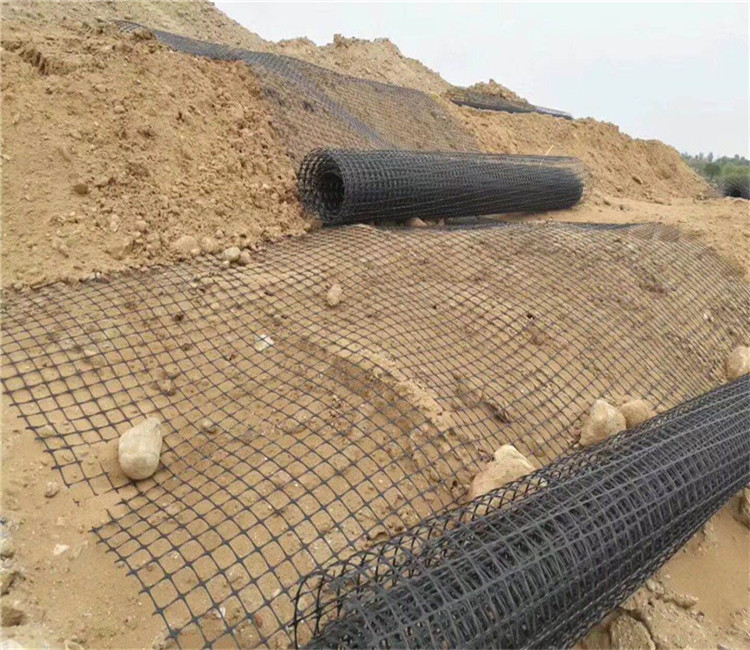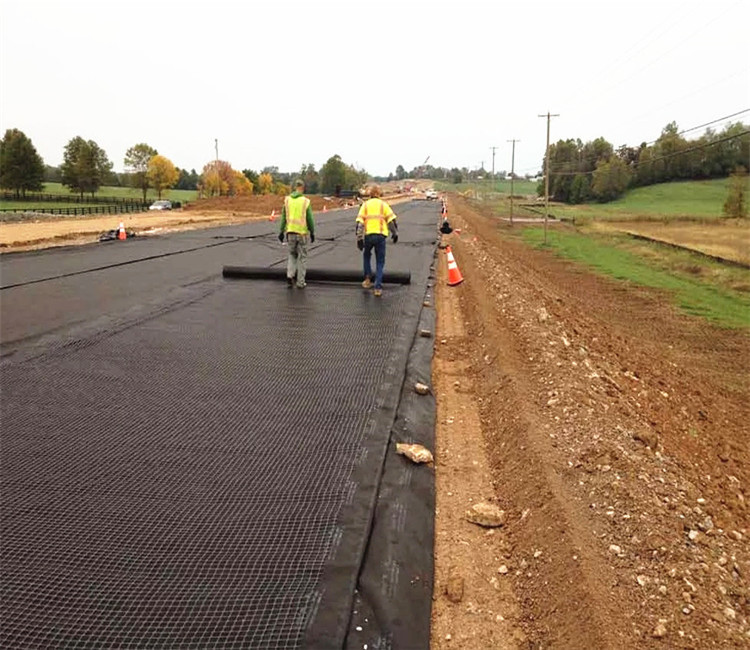09
2019
-
03
Key Points of Construction Technology of Geogrid Applied to Subgrade Widening and Reinforcement
Author:
As a flexible material, geogrids can withstand great tensile stress. The setting of Geogrids in the tension deformation area of soil can effectively transfer the tension stress of soil and promote the steel bar to become a tension member. Under the action of load, the friction between Geogrid and soil will restrict the lateral deformation of soil. Because of the high cohesive force between Geogrid and soil, the tensile strength and shear stress are improved. The settlement of the cross section of embankment and the joint of new and old subgrade is effectively improved to avoid the occurrence of longitudinal and transverse cracks.
Below by the geogrid production base - Desheng Synthetic Material Co., Ltd. for your detailed introduction of geogrid Widening Roadbed Reinforcement Construction Technology Points
I. Preparation of Construction Materials
(1) Packing. The materials selected for filling are mainly sandy soil, gravel and gravel, which have strong water permeability. It is forbidden to select silt and humic soil. The selected filler should not be used if there are more organic materials and domestic garbage in it. Comparing with the compaction thickness of filler, the particle size of filler should not be greater than 75%, and the maximum particle size should be controlled within 15 cm. If the coarse grained material is not smooth enough and sharp enough, it should not be used when spreading the ribbon surface. There are mainly two kinds of gravel specifications, i.e. 30-50 mm c50-70 mm, and the allocation ratio is 70:30.
(2) Reinforcement materials. Geogrids and geobelts are geosynthetics used to reinforce subgrade. As a new type of geosynthetics, plastic geogrids have the advantages of strong overall structure and large friction coefficient, which have been widely used in soft foundation reinforcement construction. This paper chooses plastic two-way geogrid construction.
II. Measurement lofting
According to the design requirements, the pile top elevation is measured and determined, and the position of the pile is laid out and the control pile is set up. At the same time, the site material is checked and the reinforced earth retaining wall foundation line is determined. In addition, the section of reinforced soil slope should be checked and the grid laying should be checked. According to construction regulations, site cleaning should be done well.

III. Foundation Engineering
Before excavation, it is necessary to do a good job of positioning measurement and mark the excavation line accurately. Compared with the outer edge of the foundation, the plane size of the bottom of the groove should be 300 mm more. When the longitudinal height changes greatly, the excavation along the bottom of the longitudinal foundation trench is carried out in accordance with the step shape, and the length of each step should be controlled within 3 m.
4. Laying Geogrids
Before laying geogrid, it is necessary to test all kinds of construction materials to ensure that they meet the design requirements. The main test items are pore size, elongation and durability. When laying geogrid, overlap method can be chosen to connect two adjacent lengthways, 0.25 cm is the overlap width. When connecting the stress direction of geogrids, it is required to control the connection strength above the allowable strength in design. According to the design length requirement, strict control of the construction of geogrille material, the requirement is about 300 to 500 mm more. Geogrids and slopes are vertical and laid on flat compacted fillers to avoid overlapping and bending, and to prevent direct contact with hard angular fillers. In order to prevent the disturbance of the grille during paving and rolling filling, the tail of the geogrid should be fixed properly.

Paving and rolling
According to the actual situation of the construction site, the reasonable determination of the rock filling collection site is carried out. The maximum dry density and the optimum water content of the filler are determined under the construction condition, which is also the standard to measure the compaction degree in the construction of roller compacted filler. Select the position of the slope of mesh bag packing masonry construction, and put the green grass seeds on the slope into the mesh bag on the slope. When unloading, the spacing between the tool and the slope should be controlled within 1.5m. If the geogrid is not covered with the filler, the machine should not drive above it to avoid disturbance to the lower grille. When paving, manual + mechanical method can be selected to ensure that the paving thickness is the same, with a flat surface, and more than 3% of the cross slope. In the construction of mechanical paving, it is required that the driving direction of the machine be parallel to the slope, and that the car should not be parked in the grille without filler. When the distance between machinery and slope is less than 1.5m, the paving method can be changed to manual. Rolling construction should be carried out in time after paving and leveling each layer of filler. Rolling construction machinery is mainly vibratory roller, according to the sequence of "light pressure - heavy pressure, middle grille - tail - slope position" construction. When the distance between the rolling machinery and the slope is only 1 m, small machinery should be selected for rolling construction. It is required that the slope be first lightly compacted and then gradually compacted to the middle of the route, and disturbance of the slope surface is strictly prohibited. According to the design requirements, the compactness of subgrade should be controlled above 95%.
6. Transition Treatment of Different Settlements of Subgrade
1. Subgrade filling and excavation joint. The two-way geogrid over 40KN/M is chosen as the main construction method of subgrade filling-excavation joint. The general geogrid type is GSZ60-60. In roadbed widening construction, geogrids should be set at the step position where the old roadbed contacts with the new roadbed and the top layer of the roadbed, so as to effectively enhance the cohesion between the new and old roadbed, and ensure the rapid formation of the overall structure of the new and old roadbed under the condition of reduced uneven settlement and lateral displacement.
2. Widening the joint of old and new roadbed. Usually, when the embankment filling height is over 3 meters, the steel-plastic composite grille should be set at the position 20 centimeters away from the top of the embankment to ensure that the ultimate longitudinal tension of the steel-plastic geogrid is above 60 KN/M, the ultimate transverse tension is above 20 KN/M, and the elongation must be controlled below 5%.
Key Points of Quality Control
1. The quality of the material itself needs to be guaranteed, and regular channels should be adopted to purchase goods to ensure that there are regular quality inspection reports. The physical and mechanical properties of the materials are sampled after purchase, and the quality control of the materials is well done.
2. The construction site should do a good job of site leveling and compaction, prevent the occurrence of hard objects causing damage to the grille, and deal with uneven areas.
3. Attention should be paid to the quality control of the effect of grid laying. Reinforcement materials should be flat and compact, avoid overlapping and distortion, and the laying direction should be vertical to the vertical wall. Its paving length, width, connection mode and strength should meet the design requirements.
4. Filling blocks should not be too large, generally not more than 2/3 of the thickness of layers; paving thickness should not be less than 30 cm, after compaction should not be less than 15 cm, compaction degree should also meet construction requirements.
5. To sum up, whether the overlap of old and new roadbed is reasonable will directly affect the quality of roadbed widening in road reconstruction. The most common way is to excavate steps on the slope of the old roadbed or lay geogrids on the steps to promote the new and old roadbed to form a whole. When widening the highway roadbed, the settlement deformation of the new widened roadbed is more serious because of the problems of compaction deformation of the embankment and foundation settlement. In this case, the settlement difference between the new and the old roadbed will be increased. The application of geogrid reinforcement technology in highway roadbed construction can effectively reduce the settlement of new and old roadbed, improve the stability of roadbed, and provide a reliable guarantee for the improvement of the overall quality of highway engineering construction.
With the rapid development of social economy, the traffic volume of our country is increasing. In order to meet the current traffic demand, we must widen and rebuild the highway with large traffic volume. In highway subgrade construction, geogrids are often used as reinforcement materials for reinforced earth structures or composite materials. They are generally divided into four categories: plastic geogrids, steel-plastic geogrids, glass fiber geogrids and glass fiber polyester geogrids. Geogrid is a square grid plate formed by stretching polymer. Geogrids can be divided into different types according to different criteria. For example, according to the material quality, they mainly include two kinds: plastic geogrids and glass fiber grids. According to the processing method, it is divided into single and two-way geogrids. Geogrid is mainly used in embankment, retaining wall, soft foundation and other aspects. The application of this technology can effectively improve the stability and bearing capacity of subgrade and other structures.
undefined




